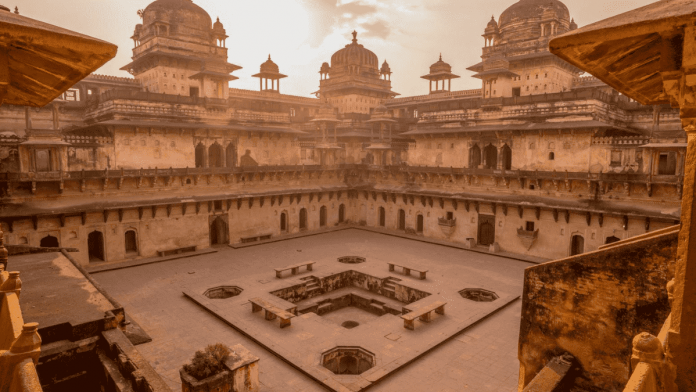Now, this time we will learn about the splendacious uniqueness of the heart of India “Incredible Madhya Pradesh”. Like the heart, which pumps the blood into our body keeping us alive and healthy, Madhya Pradesh is a life-giving factor in our country. This blog will be dealing with the culture, geography and political aspects of Madhya Pradesh.
Which state has largest reserves of Diamond and Copper in India? Which place is known as ‘Queen of Saputara’? Where is the largest Shiva lingam in India?
Let’s range over more meticulously about “the heart of India – Madhya Pradesh”.
Madhya Pradesh was formed on 1 November 1956. This central state is a credential for making India a diverse country by adding to the richness of history, culture, tradition and art. Madhya Pradesh owes much to the reign of different dynasties over a long period of time for its rich history and majestic monuments that are incredibly famous. The state is a perfect reflection of India as it is a perfect blend of both urbanity and historical events.
Let’s have a look over the State Symbols of Madhya Pradesh.
Table of Contents
STATE SYMBOLS OF MADHYA PRADESH:
| State Capital | Bhopal |
| State Flower | Madonna lily |
| State Tree | Banyan tree |
| State Animal | Barasingha |
| State Bird | Indian paradise flycatcher |
| State Dance | Maanch |
| State Governor(PRESENT) | Anandiben Patel (incumbent) |
| State Chief Minister(PRESENT) | Shivraj Singh Chouhan (incumbent) |
Let’s study the first attribute of the state i.e. social and cultural aspects.
CULTURE of Madhya Pradesh
Madhya Pradesh is a land sanctified with faith. Ancient temples, fortresses and cave works reflect the rich historical culture and tradition of Madhya Pradesh. Many traditions of the tribal peoples of Madhya Pradesh have remained strong, and a great deal of indigenous mythology and folklore has been preserved.
Traditional dance, food, language and key structures,
- In west-central Madhya Pradesh, one of the state’s oldest historical monuments is the stupa Buddhist mound forming a memorial shrine at Sanchi, near Vidisha which was originally constructed by Ashoka.
- The Bagh caves near the western town of Mhow, Madhya Pradesh are adorned with paintings on Buddhist topics that date roughly to the 5th century CE.
- Khajuraho can be rightly called as the epitome of Indian art. A group of 22 temples makes Khajuraho famous all over the world. The intricate carvings and the fine erotic sculpture art makes it more famous and can make any history lover fall in love with its art.
- In Bhopal there is a unique multifaceted cultural complex named Bharat Bhavan, which functions as a meeting ground for artists from various fields; the sprawling complex houses a museum, a library, an open-air theatre, and a number of conference halls.
- The state has important yearly religious melas in Mandsaur and Ujjain, both in the Malwa region of western Madhya Pradesh.
- Largest shiv lingam in India is situated in Bhojpur in Madhya Pradesh.
- The Pachmarhi hills are often referred to as ‘Saputara ki Rani’ which means ‘Queen of Saputara’. This is a hill station which is located at an altitude of 1110m is the only hill station in Madhya Pradesh.
- Maanch dance is a lyrical folk dance and drama which is performed in the native Malwi language which hails from Malwa region and is a state dance of Madhya Pradesh.
- Hindi is the official state language and is most widely spoken in Madhya Pradesh.
- Madhya Pradesh cuisine comprises a wide variety of traditional food items that vary regionally. Wheat is the staple food of the state. Some famous vegetarian dishes include poha and jalebi, bhutte ki khees, and dal bafla. Popular non-vegetarian dishes include gosht korma, kebabs, and roghan josh.
Now, let’s come to the geographical aspects of Madhya Pradesh.
GEOGRAPHY of Madhya Pradesh
Madhya Pradesh is called the “heart of India” due to its geographical location in India and is the second-largest state in the country by area after the western state of Rajasthan. As its name implies, Madhya means “central” and Pradesh means “region” or “state” and the state is in central India. Madhya Pradesh is well known for its regal forts, breathtaking topography, exhilarating wildlife, caves, and magnificent temples.
- Total Area: 308,252km2
Area Rank in India: 2nd
- Total Population: 72,626,809
Population Rank in India: 5th
Latitude extension: 21.6° N to 26.30° N
Longitudinal extension: 74°9’ E to 82°48’ E
- The state has no coastline and no international frontier. It is bounded by Uttar Pradeshto the northeast, Chhattisgarh to the southeast, Maharashtra to the south, Gujarat to the southwest, and Rajasthan to the northwest.
- The state straddles the Narmada River, which flows from east and west between the Vindhya and Satpura ranges. These ranges and the Narmada River are the traditional boundaries between the north and south of India. The highest point in Madhya Pradesh is Dhupgarh, with a height of 1,350 m.
- More than 30% of Madhya Pradesh is under forest cover. It is home to nine National Parks, a number of natural preserves and three of the eighteen biosphere reserves in India namelyPachmarhi Biosphere Reserve, Amarkantak Biosphere Reserve and Panna National Park.
- The teak, sal and bamboo forests of Kanha, Bandhavgarh, Panna and Pench house an amazing variety of wildlife: more than 22 species of mammals and 250 species of birds.
Climate:
Madhya Pradesh has a subtropical climate with a hot dry summer (April–June), followed by monsoon rains (July–September) and cool and relatively dry winter. The average rainfall is about 1,194 mm.
Soil type:
The major types of soils found in the state are:
- Blacksoil, in the Malwa region, Mahakoshal and southern Bundelkhand
- Red and yellow soil, in the Baghelkhand region
- Alluvial soil, in Northern Madhya Pradesh
- Laterite soil, in highland areas
- Mixed soil, in parts of the Gwalior and Chambal divisions
Let’s take a glance over the Political structure of the state.
GOVERNMENT AND POLITICS of Madhya Pradesh
The structure of the government of Madhya Pradesh, like that of most other states of India, is determined by the national constitution of 1950.
- The head of state is the governor, who is appointed by the president of India.
- The governor is aided and advised by the Council of Ministers, which is headed by Chief Minister and is responsible for the elected, unicameral Legislative Assembly (Vidhan Sabha).
- The High court of MP is located in Jabalpur, with two benches at Gwalior and Indore from which appeals can be made to the Supreme Court of India. Lower courts include district courts and family courts.
- The dominant political parties in the state are the Bharatiya Janata Party (BJP) and the Indian National Congress.
- At the local level, the state is divided administratively into a number of divisions, which are further subdivided into numerous districts.
- Each division is headed by a commissioner and each district by a collector. The collector exercises both executive and magisterial power.
Representation of Madhya Pradesh in Parliament:
Assembly seats (unicameral): 230
Rajya Sabha: 11
Lok Sabha: 29
First Governor of Madhya Pradesh: Shri B. Pattabhi Sitaramaiya
First Chief Minister of Madhya Pradesh: Shri Ravi Shankar Shukla
SOME INTERESTING FACTS ABOUT MADHYA PRADESH:
- Rudyard Kipling, who was the writer of the most famous novel the Jungle Book, found his inspiration in the wondrous habitat of Madhya Pradesh.
- Madhya Pradesh has three UNESCO World Heritage sites:
- 3rd century BC Buddhist temples at Sanchi built by Emperor Ashoka
- the sensually-carved Hindu-Jain temples of Khajuraho that celebrate love, built between 950 AD and 1050 AD by the Chandela Rajput kings
- 17,000-year-old rock paintings of Bhimbetka which throw light on the life and times of Stone Age man
- Madhya Pradesh has the largest reserves of Diamond and Copper in India.
- Karera Bird Sanctuary in Shivpuri district, Madhya Pradesh is famous for the Great Indian Bustard (Son Chidiya).
- Ujjain is one of the four places where Kumbh mela is organised in every 12 years which is situated on the banks of Kshipra River. The other 3 places are Nashik, Allahabad and Haridwar.
CONCLUSION
Hope this discourse made most of your facts crystal clear about the heart of India, Madhya Pradesh. In our upcoming write-up, we will be discussing about other important attributes of Madhya Pradesh.
Which part of Madhya Pradesh is famous for Bauxite, Copper and Dolomite? What are the historical aspects of Madhya Pradesh? Which state is famous for Honey production in India?
In our further article, the factors corresponding to these questions will be answered surely. If you don’t want to miss it, click here – Know your State ‘Madhya Pradesh’ – Part 2. We hope it will help you in the preparation of your competitive exams such SSC 10+2, SSC CGL, CDS, NDA, etc.
Thank You




